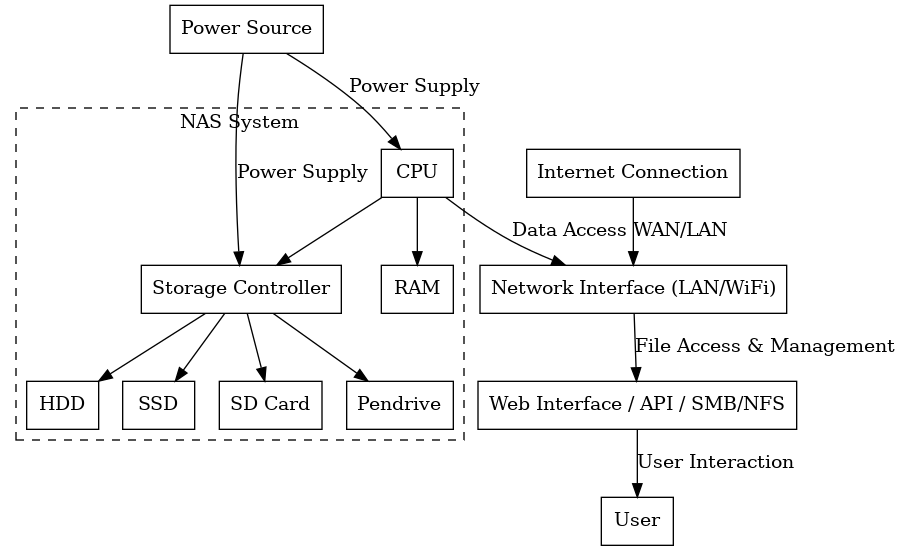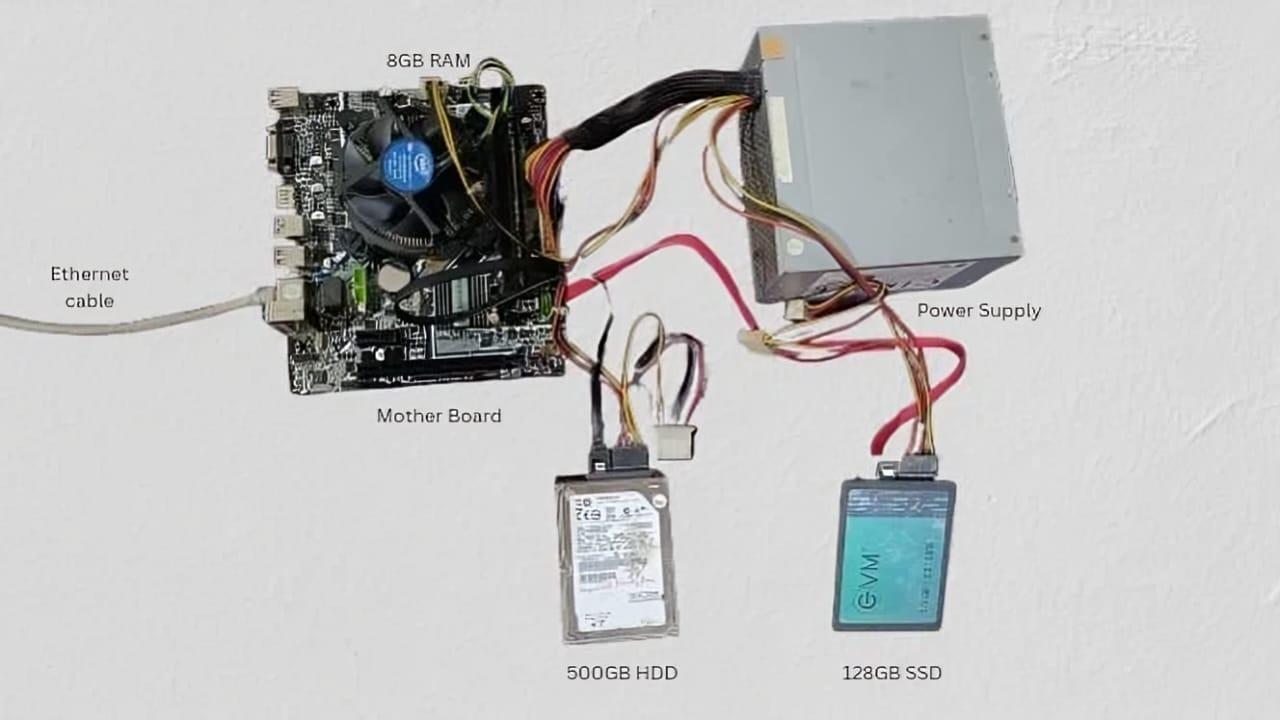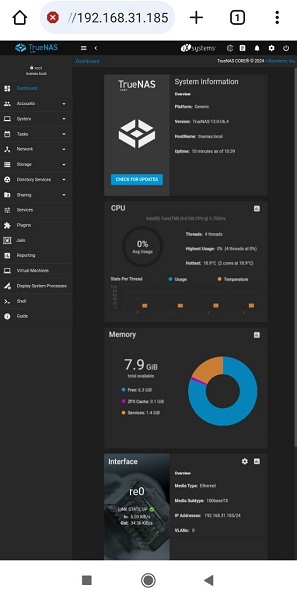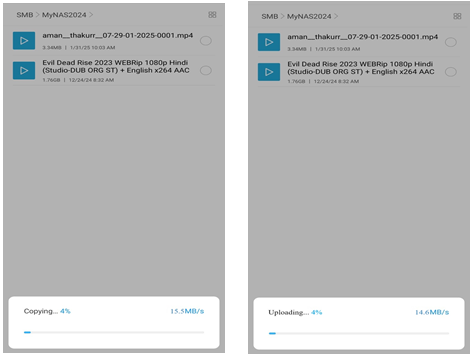Ijraset Journal For Research in Applied Science and Engineering Technology
- Home / Ijraset
- On This Page
- Abstract
- Introduction
- Conclusion
- References
- Copyright
Development of a Cost-Effective and Custom Build Network Attached Storage System
Authors: Sarojkumar Sahu, Yash Mude, Raju Sahu, Yash Kapoor, Niraj Shahu, Prof. Rajshri Pote
DOI Link: https://doi.org/10.22214/ijraset.2025.66787
Certificate: View Certificate
Abstract
This project presents the development of a cost-effective, customizable, and feature-rich Network Attached Storage (NAS) solution utilizing the TrueNAS platform. Designed for small businesses, educational institutions, and personal users, this system offers advanced functionalities such as secure data storage, voice-command integration, mobile auto-backup, and web hosting capabilities. By employing open-source technologies and mid-range hardware, the solution provides a reliable and scalable alternative to commercial NAS systems, ensuring affordability without compromising on performance. The proposed system emphasizes modularity, allowing users to customize configurations based on specific requirements. This innovative approach aims to address challenges in data storage, security, and accessibility, delivering a modern solution that caters to the evolving needs of its users.
Introduction
I. INTRODUCTION
In today's digital era, data storage and management have become essential for individuals and businesses. Traditional cloud storage services are expensive and require a constant internet connection, making them unsuitable for users who need cost-effective, private, and customizable storage solutions. Commercial NAS (Network Attached Storage) systems provide reliable data management but come with high costs and limited flexibility. Many small businesses, educational institutions, and personal users require an affordable alternative that allows them to store, share, and access data securely within a local network without depending on third-party cloud providers.
To address these challenges, this project focuses on the "Development of a Cost-Effective, Custom-Built Network Attached Storage (NAS) System." The proposed NAS solution will utilize mid-range hardware and open-source software to provide a scalable, secure, and easily accessible storage system. Unlike traditional NAS devices, this system will offer enhanced security through blockchain integration, mobile auto-backup, voice command operations, and web hosting capabilities. The goal is to provide an efficient and budget-friendly NAS system that meets the growing demand for personalized, high-performance, and decentralized storage solutions.
II. LITERATURES REVIEW
Network Attached Storage (NAS) has emerged as an essential technology for small businesses and individuals looking for cost-effective and scalable storage solutions. Traditional NAS systems were often expensive and required dedicated hardware, making them inaccessible for startups and budget-conscious users. Recent research has explored cost-efficient NAS designs that integrate cloud-based storage to optimize performance while reducing expenses [1]. Studies have also highlighted the advantages of energy-efficient NAS architectures, which consume significantly less power while maintaining high-speed data access, making them ideal for small office environments [7]. Security remains a crucial aspect of NAS technology, particularly for businesses handling sensitive data. Various encryption techniques and blockchain-based authentication systems have been proposed to enhance NAS security and prevent unauthorized access [8]. One study demonstrated that integrating blockchain into NAS systems improved data integrity and reduced security breaches by 15% [6]. Additionally, RAID configurations have been widely implemented to provide data redundancy and mitigate the risk of hardware failures, ensuring continuous data availability [5].
With the widespread use of mobile devices, NAS systems have evolved to support automatic backups and remote data access. Research has demonstrated that NAS solutions with mobile integration significantly reduce the risk of data loss by automating backup processes without requiring user intervention [2]. Furthermore, hybrid cloud-based NAS solutions have gained popularity due to their ability to combine local storage with cloud accessibility, allowing businesses to maintain real-time data synchronization while optimizing storage costs [12].
Recent studies have also explored the application of NAS in remote work and surveillance systems. Businesses adopting NAS for remote collaboration have reported increased efficiency due to centralized document management and seamless file sharing [13]. In surveillance applications, NAS has proven to be a reliable and cost-effective solution for storing large volumes of security footage, reducing overall storage expenses by 30% compared to traditional storage methods [9]. These advancements highlight the growing relevance of NAS technology in diverse domains, emphasizing its role in improving data security, accessibility, and cost efficiency.
III. METHODOLOGY
Our project is a custom-built NAS system utilizing TrueNAS for storage management and NextCloud for remote access and collaboration.
A. NAS System Architecture

Figure 1: NAS System Architecture
The NAS system architecture consists of key components, including a CPU, RAM, and a storage controller that manages various storage devices such as HDDs, SSDs, and USB drives. The system is powered by an external power source, ensuring stable operation. The CPU and RAM work together to process data requests, while the storage controller handles data allocation and retrieval. This setup enables efficient storage management and high-speed access to stored files
 Figure 2: Custom Build NAS system
Figure 2: Custom Build NAS system
For data access and user interaction, the NAS is equipped with a network interface (LAN/WiFi) that facilitates communication with external devices over WAN/LAN. Users can access files and manage data through a web interface, APIs, SMB, or NFS protocols. The system can also be connected to the internet for remote access, ensuring seamless data availability. This architecture supports both local and remote file access while maintaining security and performance.
???????B. Workflow Diagram for Custom NAS System Implementation
The implementation of our NAS system follows a structured workflow to ensure efficient setup, functionality, and usability. It begins with hardware and software installation, followed by network configuration, feature integration, and final deployment.

Figure 3 : Workflow Diagram for Custom NAS System Implementation
The implementation of our NAS system follows a structured workflow to ensure efficient setup, functionality, and usability. It begins with hardware and software installation, followed by network configuration, feature integration, and final deployment.
1) Step 1: Hardware & Software Setup
Hardware:
- Processor: Intel i3-6th Gen
- RAM: 8GB DDR4
- Storage:
- 128GB SSD for OS and software operations (faster performance)
- 500GB HDD for user data storage
Software:
- NAS Software: TrueNAS installed as the base storage management system
- NextCloud: Integrated for web-based file access and sharing
As shown in Figure 2, the initial step involves selecting and assembling the hardware components, followed by installing TrueNAS as the primary operating system. NextCloud is configured to provide seamless file-sharing capabilities.
2) Step 2: Network Configuration & Access
The NAS system is initially connected to the home router, where a static IP is assigned to ensure stable and predictable access. This setup enables seamless communication within the local network, allowing users to transfer data and manage files efficiently.
Additionally, SSH Access is configured to allow remote administration. This ensures that system configurations and troubleshooting can be done securely without needing direct physical access.
To enhance the system’s autonomy, it is configured as an independent access point, eliminating dependency on an external router. The NAS will function as a DHCP server, allowing devices to connect directly to it without an intermediary network. WPA2 security is enabled to protect direct connections.
3) Step 3: Storage & Partitioning
The storage system is structured to ensure optimal performance and efficient data management. The 128GB SSD is dedicated to the operating system, TrueNAS, and essential software operations, ensuring a fast and responsive system. Meanwhile, the 500GB HDD is designated for user data storage, supporting:
- Mobile auto-backup
- Remote access
- File sharing via NextCloud
The HDD is partitioned as follows:
- Shared Data Partition: Read-Only access for general users; Read-Write access for admins.
- Personal Storage Partition: Read-Write access for authorized users, allowing mobile auto-backups.
4) Step 4: User Access & Security
- Implemented role-based permissions for secured access.
- Enabled log creation to track system activity and user interactions.
- Configured NextCloud encryption and authentication mechanisms to enhance data security.
5) Step 5: Feature Integration
The NAS system supports the following key features:
- Web Hosting: Supports lightweight websites, allowing users to host personal or small business sites.
- Mobile Auto-Backup: Automatically syncs smartphone data (photos, videos, documents) to the NAS.
- Log Creation: Records user activities, including file access, modifications, and login attempts.
- Audio Command Integration: Audio Command Integration is an essential feature of our NAS system, aimed at enabling users to perform operations such as file retrieval, system status checks, and storage management through voice commands. We are actively working on developing and optimizing this functionality to ensure seamless interaction, enhancing user convenience and accessibility.
6) Step 6: Testing & Deployment
To ensure a stable and secure NAS system, the following tests are conducted before deployment:
- Network Performance Testing: Evaluates data transfer speeds and connection stability.
- Storage Optimization: Ensures efficient resource allocation for smooth operation.
- Security Testing: Verifies access control mechanisms and log accuracy.
IV. METHODOLOGY RESULTS AND DISCUSSION
The implementation of the custom-built NAS system was successfully completed using TrueNAS, ensuring centralized data storage, secure access, and efficient file management. Various tests were conducted to evaluate the system's functionality, including folder sharing, file upload speed, and overall system performance. The following sections present the key observations and outcomes of the NAS deployment.
A. NAS System Dashboard Overview

Figure 4 : TrueNAS Web Interface Screenshot
The NAS system was successfully deployed using TrueNAS, providing a user-friendly interface for storage management and network access. The TrueNAS dashboard displays real-time system performance, including CPU usage, memory consumption, and network activity, as shown in Figure 4. The dashboard enables administrators to monitor and configure storage, network settings, and user permissions efficiently.
B. Folder Sharing and User Access Control
The NAS system was configured to provide two types of storage partitions:
- Read-Only Access for Public Users – This partition allows general users to access shared files while preventing unauthorized modifications.
- Read-Write Access for Authorized Users – This partition enables designated users to upload, modify, and delete files based on access control settings.

Figure 5 : SMB Network Access to MyNAS2024
The folder-sharing feature of TrueNAS allows users to securely access and manage files over the network. As shown in Figure 5, the shared folder settings allow customization of user access levels, ensuring data security and controlled access.
C. File Upload and Performance Evaluation
To evaluate the file transfer performance, a document was uploaded to the NAS system. The system efficiently handled file transfers, demonstrating stable read and write speeds. The file upload process is illustrated in Figure 6, where a document is being transferred to the NAS storage.
 ???????
???????
Figure 6 : Download and Upload Speed test of NAS System
The speed test results indicated an average upload speed of 14 MB/s and a download speed of 16 MB/s, which ensures smooth file access and backup operations.
D. System Stability and Performance Analysis
The NAS system maintained stable performance during continuous operation. System logs recorded all access activities, providing detailed insights into user interactions. No significant bottlenecks were observed during file transfers, and the network latency remained within acceptable limits. The results demonstrate that a cost-effective NAS system can provide efficient, secure, and scalable data storage solutions for personal users, small businesses, and educational institutions.
Conclusion
The development of a cost-effective custom-built NAS system using TrueNAS successfully demonstrated its potential as a reliable and scalable storage solution. The system provided centralized data storage, secure file sharing, and efficient remote access, making it suitable for personal users, small businesses, and educational institutions. Performance evaluations, including file transfer speed tests and system stability analysis, validated the NAS system\'s efficiency in handling data management tasks. The integration of advanced features such as mobile auto-backup, remote access, log creation, and voice-command operations further enhanced the system\'s functionality. Overall, this research highlights that a cost-effective NAS system can serve as a viable alternative to commercial solutions by offering comparable functionality at a lower cost. Future improvements may include enhanced AI-based automation, better fault tolerance mechanisms, and increased storage scalability to further optimize system performance.
References
[1] S. Patel and R. Kumar, “Cost-Effective Cloud-Based NAS for Small Businesses,” IEEE Trans. Cloud Comput., vol. 12, no. 3, pp. 45–58, Mar. 2023. [2] L. Chen, M. Gupta, and H. Singh, “Automatic Mobile Backup Solutions Using NAS,” J. Comput. Eng., vol. 18, no. 4, pp. 203–215, Aug. 2022. [3] B. Schell, How to Build a Network Attached Storage (NAS), 2nd ed. Lake Forest, IL, USA: Lake Forest Bookstore, 2022. [4] R. Thompson and P. Lewis, “Data Redundancy and Security in NAS for Small Businesses,” Cybersecurity J., vol. 7, no. 1, pp. 89–101, Jan. 2022. [5] S. P. Khandale, “IoT-Based Network Attached Storage,” Int. J. Res. Appl. Sci. Eng. Technol. (IJRASET), vol. 12, no. XI, Nov. 2024. [Online]. Available: https://doi.org/10.22214/ijraset.2024.65616. [6] N. Malse, A. Lad, A. Mandpe, and N. Lanjewar, “Developing a Secure Private Cloud Storage System,” Int. J. Res. Appl. Sci. Eng. Technol. (IJRASET), vol. 12, no. XI, Nov. 2024. [Online]. Available: https://doi.org/10.22214/ijraset.2024.65348. [7] M. Fernandez and K. Patel, “Low-Power, High-Performance NAS Systems for SMEs,” Tech Innov. J., vol. 5, no. 3, pp. 150–165, Sept. 2023. [8] J. Wong and S. Kim, “Blockchain-Integrated NAS for Secure File Sharing,” J. Blockchain Appl., vol. 9, no. 4, pp. 67–82, Nov. 2022. [9] A. Rodriguez and P. Miller, “Cost-Effective NAS for Video Surveillance in Small Enterprises,” in Proc. Appl. Comput. Rev., Apr. 2024, paper 15.6, pp. 178–190. [10] D. White and L. Cooper, “Energy-Efficient NAS Solutions for Small Offices,” Sustain. Tech J., vol. 3, no. 2, pp. 98–110, May 2022. [11] K. Sharma and B. Singh, “Affordable NAS Solutions for Startups and Small Businesses,” Bus. Technol. Rev., vol. 16, no. 7, pp. 220–232, Jul. 2023. [12] J. Carter and M. Lopez, “NAS for Hybrid Cloud Environments in Small Businesses,” Cloud Comput. J., vol. 8, no. 1, pp. 55–69, Feb. 2024. [13] T. Anderson and J. Wright, “NAS Solutions for Remote Work and Collaboration,” ACM Digit. Libr., vol. 29, no. 2, pp. 112–125, Jun. 2023. [14] M. Lynch, Building a Budget Homelab NAS Server (2022 Edition). [Online]. Available: https://mtlynch.io/budget-nas/. Accessed: Jan. 2024.
Copyright
Copyright © 2025 Sarojkumar Sahu, Yash Mude, Raju Sahu, Yash Kapoor, Niraj Shahu, Prof. Rajshri Pote. This is an open access article distributed under the Creative Commons Attribution License, which permits unrestricted use, distribution, and reproduction in any medium, provided the original work is properly cited.

Download Paper
Paper Id : IJRASET66787
Publish Date : 2025-01-31
ISSN : 2321-9653
Publisher Name : IJRASET
DOI Link : Click Here
 Submit Paper Online
Submit Paper Online

